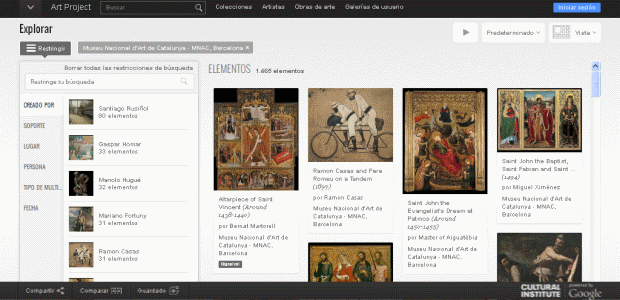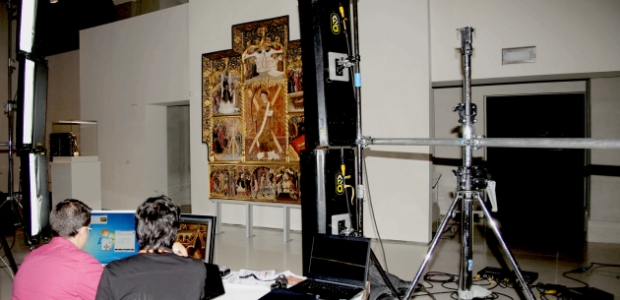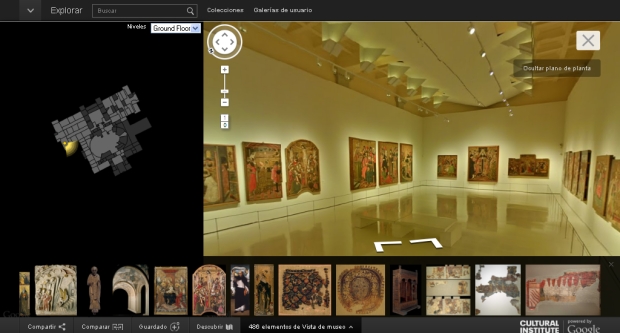
When Google Art Project appeared on the scene in February 2011, the Museu Nacional had only just made available the online collection and had published the catalogue of the works exhibited in the rooms, making them more accessible.
Once we had got over the first impulse of finding out how to contact Google and to know what we had to do so as to form part of the Art Project, we started to ask ourselves a whole load of questions. One thing was to publish on our institutional website the catalogue inventory, another thing, very different, was to make the collection accessible on an external platform of extensive reach. Would this take away potential onsite visits? Would the people not go to the museum because they already knew the works online or would they come to take a closer look at the works that they had already seen virtually? This was, and still is, a debate in which not all the museums have the same opinion.
After giving some thought to it, we reached the conclusion that it was a magnificent opportunity to make a museum such as ours known, which internationally isn’t one of the best positioned, and also artists and works that for us are very close but, however, haven’t had the critical fortune that other had obtained in an international context. Making a simile of the publishing world on paper, we considered that an alliance with Google, when posting on the net the catalogue of the collection, would become a major joint international edition, through a platform that would offer us a universal distribution.
We managed to do so: now we needed to get down to work
With the support of the management and after Google Art Project had shown interest in our participation in the second phase of the project, foreseen for April 2012, we started the task for true. And we didn’t do so step by step: we decided we would post on the net all the works exhibited in the rooms, around some 1,900. At that time we didn’t know what working with universal metadata language represented and the problems caused by the incompatibility of the languages. Nevertheless, the fact of searching for and finding solutions has been very useful for us when we subsequently participated in other projects, such as, for example, Europeana, and when we have had to share metadata with other museums and institutions all over the world.
This experience has also been useful for us so as to see that in the digital field the issue of author rights was a pending subject for the agencies that manage them. We have had to renounce publishing works that had author rights in force. That’s why finally we only published 1,464 works in Google Art Project.

However, we didn’t give up either the gigaphoto or the virtual visit with the technique of the Google Street View. It represented an important internal task of coordination and in which we needed the collaboration and understanding of the whole of the museum because we had to film without people, and even at night without natural light. But the results were well worth it. The tour of the rooms is a good tool for virtual users to get to know the spaces of the museum and the works we house, and the gigaphoto of the Altarpiece of sant Vicenç by Bernat Martorell allows us to capture the extraordinary details that with the naked eye often go unnoticed. They are two invaluable experiences for the users.

The results are positive and we think that the museum and the artists present now are better known at an international level, and that now looking back, we value the fact of forming part of a living project, which is growing not only in terms of the number of artists, works and new museum participants, but also in new features such as personalisation of our own exhibitions and collections or the use of the tool for educational and learning aims.
We continue participating in collaborative digital projects
For everything mentioned above, when afterwards we have had the opportunity to participate in two projects of Europeana (Partage Plus and Photography, the repository of digital heritage boosted by the European Union, or in Digital Memory of Catalonia, in collaboration with the Biblioteca de Catalunya (Library of Catalonia) and the Catalan Universities, we’ve jumped straight in once again, without any doubt whatsoever. These types of initiatives are good opportunities that allow us to learn and grow as a museum in all the fields: knowledge, social use, diffusion, research, etc. All in all, in everything that is the essence of our very existence.
What do you think: is participating in these kinds of events an opportunity or are they competition?
Related links
Google Art Project and its role in the Artworld
Google Street View. Catalonia Highlight
Projectes digitals







